英语倒装句用法
- 格式:doc
- 大小:121.50 KB
- 文档页数:15
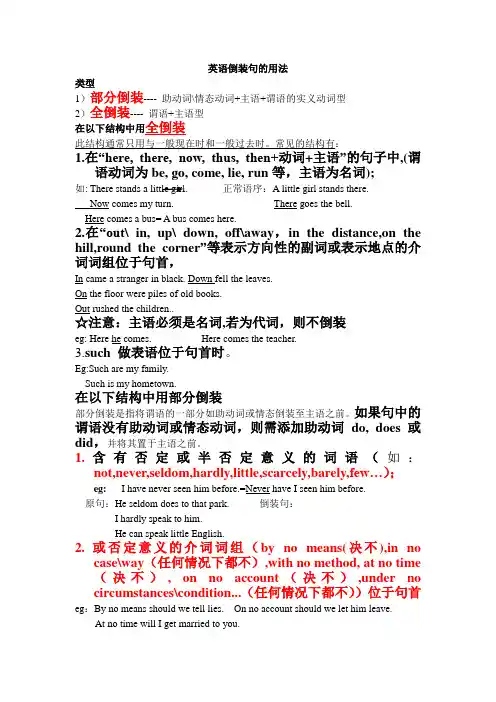
英语倒装句的用法类型1)部分倒装---- 助动词\情态动词+主语+谓语的实义动词型2)全倒装---- 谓语+主语型在以下结构中用全倒装此结构通常只用与一般现在时和一般过去时。
常见的结构有:1.在“here, there, now, thus, then+动词+主语”的句子中,(谓语动词为be, go, come, lie, run等,主语为名词);如: There stands a little girl. 正常语序:A little girl stands there.Now comes my turn. There goes the bell.Here comes a bus= A bus comes here.2.在“out\ in, up\ down, off\away,in the distance,on the hill,round the corner”等表示方向性的副词或表示地点的介词词组位于句首,In came a stranger in black. Down fell the leaves.On the floor were piles of old books.Out rushed the children..☆注意:主语必须是名词,若为代词,则不倒装eg: Here he comes. Here comes the teacher.3.such 做表语位于句首时。
Eg:Such are my family.Such is my hometown.在以下结构中用部分倒装部分倒装是指将谓语的一部分如助动词或情态倒装至主语之前。
如果句中的谓语没有助动词或情态动词,则需添加助动词do, does或did,并将其置于主语之前。
1.含有否定或半否定意义的词语(如:not,never,seldom,hardly,little,scarcely,barely,few…);eg:I have never seen him before.=Never have I seen him before.原句:He seldom does to that park. 倒装句:I hardly speak to him.He can speak little English.2.或否定意义的介词词组(by no means(决不),in nocase\way(任何情况下都不),with no method, at no time (决不), on no account(决不),under no circumstances\condition...(任何情况下都不))位于句首eg:By no means should we tell lies. On no account should we let him leave.At no time will I get married to you.In [Under] no circumstances will I lend money to him.注意:in no time(立即,马上)位于句首时,其后无需用倒装语序:In no time he worked out the problem. 他马上就算出了那道题3.或者含有否定意义的连词(not only…but also..,neither..nor.., no sooner had…than...(一。
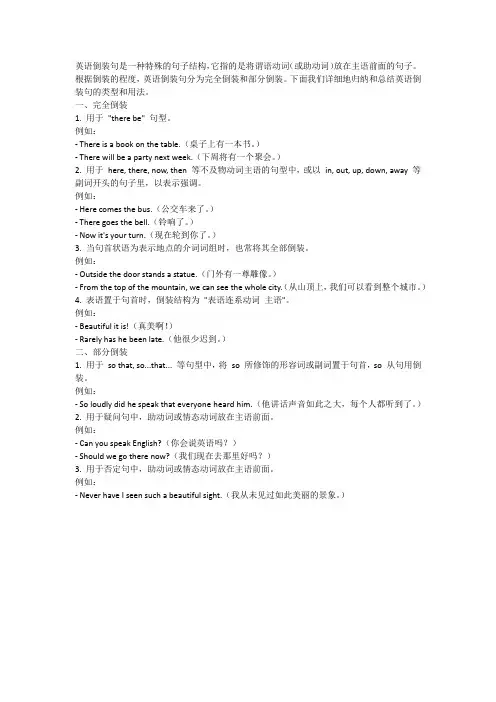
英语倒装句是一种特殊的句子结构,它指的是将谓语动词(或助动词)放在主语前面的句子。
根据倒装的程度,英语倒装句分为完全倒装和部分倒装。
下面我们详细地归纳和总结英语倒装句的类型和用法。
一、完全倒装1. 用于"there be" 句型。
例如:- There is a book on the table.(桌子上有一本书。
)- There will be a party next week.(下周将有一个聚会。
)2. 用于here, there, now, then 等不及物动词主语的句型中,或以in, out, up, down, away 等副词开头的句子里,以表示强调。
例如:- Here comes the bus.(公交车来了。
)- There goes the bell.(铃响了。
)- Now it's your turn.(现在轮到你了。
)3. 当句首状语为表示地点的介词词组时,也常将其全部倒装。
例如:- Outside the door stands a statue.(门外有一尊雕像。
)- From the top of the mountain, we can see the whole city.(从山顶上,我们可以看到整个城市。
)4. 表语置于句首时,倒装结构为"表语连系动词主语"。
例如:- Beautiful it is!(真美啊!)- Rarely has he been late.(他很少迟到。
)二、部分倒装1. 用于so that, so...that... 等句型中,将so 所修饰的形容词或副词置于句首,so 从句用倒装。
例如:- So loudly did he speak that everyone heard him.(他讲话声音如此之大,每个人都听到了。
)2. 用于疑问句中,助动词或情态动词放在主语前面。
例如:- Can you speak English?(你会说英语吗?)- Should we go there now?(我们现在去那里好吗?)3. 用于否定句中,助动词或情态动词放在主语前面。
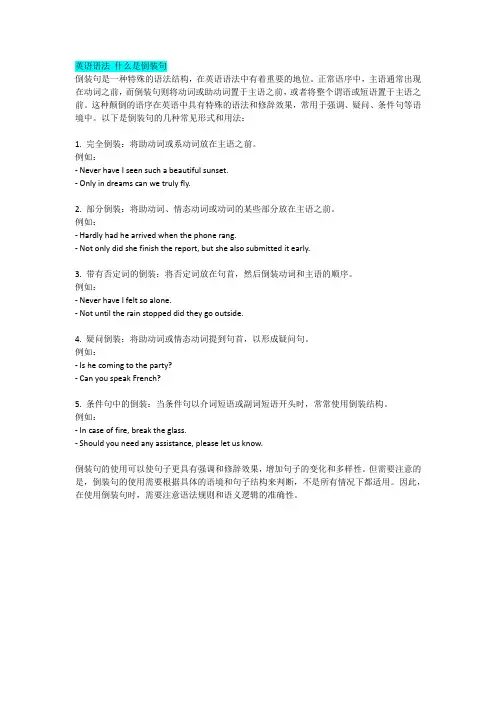
英语语法什么是倒装句倒装句是一种特殊的语法结构,在英语语法中有着重要的地位。
正常语序中,主语通常出现在动词之前,而倒装句则将动词或助动词置于主语之前,或者将整个谓语或短语置于主语之前。
这种颠倒的语序在英语中具有特殊的语法和修辞效果,常用于强调、疑问、条件句等语境中。
以下是倒装句的几种常见形式和用法:1. 完全倒装:将助动词或系动词放在主语之前。
例如:- Never have I seen such a beautiful sunset.- Only in dreams can we truly fly.2. 部分倒装:将助动词、情态动词或动词的某些部分放在主语之前。
例如:- Hardly had he arrived when the phone rang.- Not only did she finish the report, but she also submitted it early.3. 带有否定词的倒装:将否定词放在句首,然后倒装动词和主语的顺序。
例如:- Never have I felt so alone.- Not until the rain stopped did they go outside.4. 疑问倒装:将助动词或情态动词提到句首,以形成疑问句。
例如:- Is he coming to the party?- Can you speak French?5. 条件句中的倒装:当条件句以介词短语或副词短语开头时,常常使用倒装结构。
例如:- In case of fire, break the glass.- Should you need any assistance, please let us know.倒装句的使用可以使句子更具有强调和修辞效果,增加句子的变化和多样性。
但需要注意的是,倒装句的使用需要根据具体的语境和句子结构来判断,不是所有情况下都适用。
因此,在使用倒装句时,需要注意语法规则和语义逻辑的准确性。
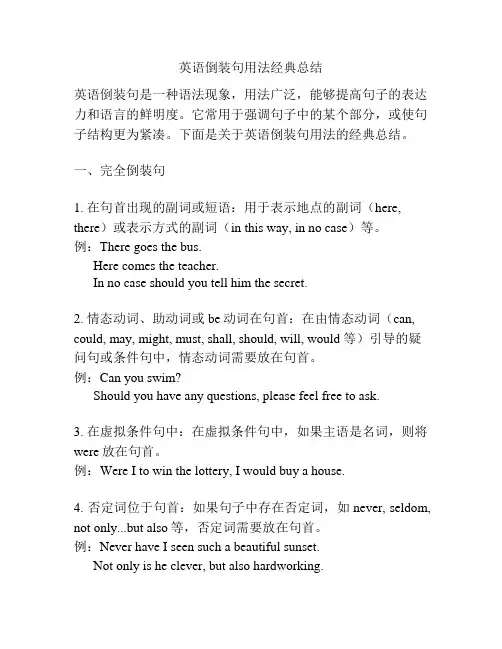
英语倒装句用法经典总结英语倒装句是一种语法现象,用法广泛,能够提高句子的表达力和语言的鲜明度。
它常用于强调句子中的某个部分,或使句子结构更为紧凑。
下面是关于英语倒装句用法的经典总结。
一、完全倒装句1. 在句首出现的副词或短语:用于表示地点的副词(here, there)或表示方式的副词(in this way, in no case)等。
例:There goes the bus.Here comes the teacher.In no case should you tell him the secret.2. 情态动词、助动词或be动词在句首:在由情态动词(can, could, may, might, must, shall, should, will, would等)引导的疑问句或条件句中,情态动词需要放在句首。
例:Can you swim?Should you have any questions, please feel free to ask.3. 在虚拟条件句中:在虚拟条件句中,如果主语是名词,则将were放在句首。
例:Were I to win the lottery, I would buy a house.4. 否定词位于句首:如果句子中存在否定词,如never, seldom, not only...but also等,否定词需要放在句首。
例:Never have I seen such a beautiful sunset.Not only is he clever, but also hardworking.5. Only修饰副词、介词短语或状语从句时:当only修饰副词、介词短语或状语从句时,倒装现象会出现。
例:Only in this way can we solve the problem.Only when he arrived did she start to cook.6. 某些表示条件的介词短语:由in case, in the event that或on condition等表示条件的介词短语引导的句子中,介词短语需要放在句首。
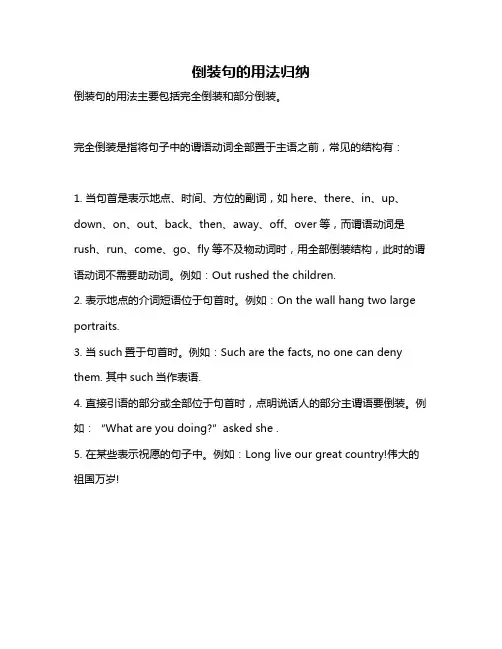
倒装句的用法归纳
倒装句的用法主要包括完全倒装和部分倒装。
完全倒装是指将句子中的谓语动词全部置于主语之前,常见的结构有:
1. 当句首是表示地点、时间、方位的副词,如here、there、in、up、down、on、out、back、then、away、off、over等,而谓语动词是rush、run、come、go、fly等不及物动词时,用全部倒装结构,此时的谓语动词不需要助动词。
例如:Out rushed the children.
2. 表示地点的介词短语位于句首时。
例如:On the wall hang two large portraits.
3. 当such置于句首时。
例如:Such are the facts, no one can deny them. 其中such当作表语.
4. 直接引语的部分或全部位于句首时,点明说话人的部分主谓语要倒装。
例如:“What are you doing?”asked she .
5. 在某些表示祝愿的句子中。
例如:Long live our great country!伟大的祖国万岁!
部分倒装是指将谓语的一部分如助动词或情态倒装至主语之前。
如果句中的谓语没有助动词或情态动词,则需添加助动词do, does或did,并将其置于主语之前。
以上信息仅供参考,如有需要,建议查阅语法书籍或咨询英语教师。
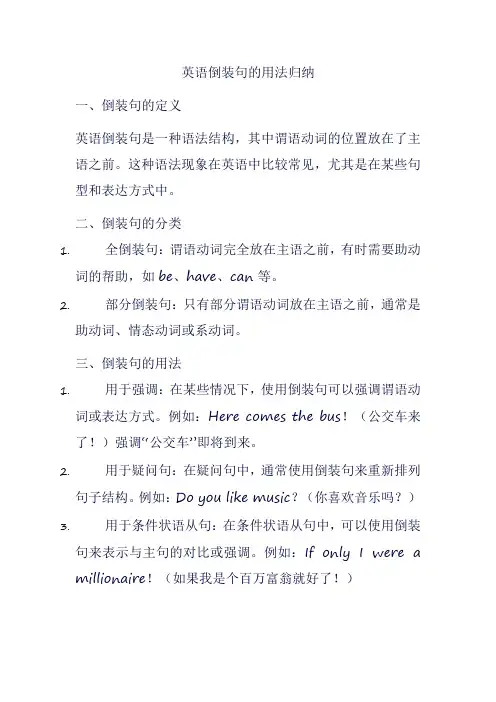
英语倒装句的用法归纳一、倒装句的定义英语倒装句是一种语法结构,其中谓语动词的位置放在了主语之前。
这种语法现象在英语中比较常见,尤其是在某些句型和表达方式中。
二、倒装句的分类1.全倒装句:谓语动词完全放在主语之前,有时需要助动词的帮助,如be、have、can等。
2.部分倒装句:只有部分谓语动词放在主语之前,通常是助动词、情态动词或系动词。
三、倒装句的用法1.用于强调:在某些情况下,使用倒装句可以强调谓语动词或表达方式。
例如:Here comes the bus!(公交车来了!)强调“公交车”即将到来。
2.用于疑问句:在疑问句中,通常使用倒装句来重新排列句子结构。
例如:Do you like music?(你喜欢音乐吗?)3.用于条件状语从句:在条件状语从句中,可以使用倒装句来表示与主句的对比或强调。
例如:If only I were a millionaire!(如果我是个百万富翁就好了!)4.用于让步状语从句:在让步状语从句中,可以使用倒装句来表示转折关系。
例如:Try to find a way to solve the problem!(试着找到解决问题的方法!)5.用于虚拟语气:在虚拟语气中,可以使用倒装句来表示与实际情况相反的情况。
例如:If I were you,I would go to the party.(如果我是你,我会去参加派对。
)6.用于某些固定句型:有些固定句型要求使用倒装句。
例如:“Hardly had she sat down when the phone rang.”(她刚坐下电话就响了。
)7.表示惊讶、感叹、讽刺等情绪时也可以使用倒装句。
例如:How could you do such a thing!(你怎么能做出这种事!)四、倒装句的用法归纳总结1.英语倒装句是一种语法结构,主要有全倒装句和部分倒装句两种类型。
2.使用倒装句可以强调谓语动词或表达方式,也可以用于疑问句、条件状语从句、让步状语从句和虚拟语气等语法结构中。
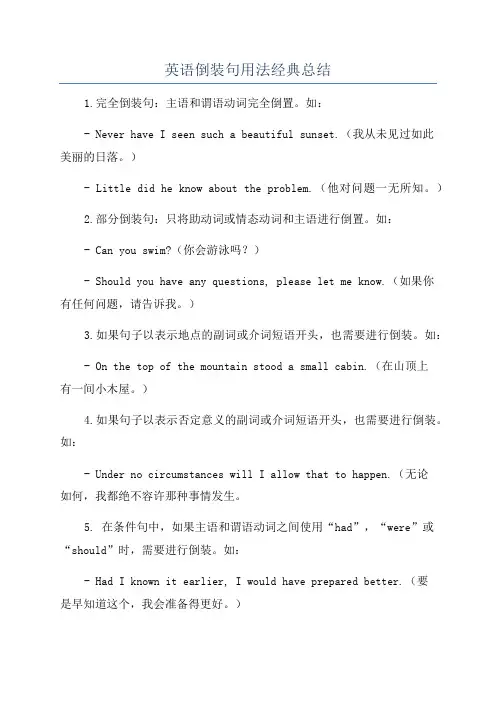
英语倒装句用法经典总结1.完全倒装句:主语和谓语动词完全倒置。
如:- Never have I seen such a beautiful sunset.(我从未见过如此美丽的日落。
)- Little did he know about the problem.(他对问题一无所知。
)2.部分倒装句:只将助动词或情态动词和主语进行倒置。
如:- Can you swim?(你会游泳吗?)- Should you have any questions, please let me know.(如果你有任何问题,请告诉我。
)3.如果句子以表示地点的副词或介词短语开头,也需要进行倒装。
如:- On the top of the mountain stood a small cabin.(在山顶上有一间小木屋。
)4.如果句子以表示否定意义的副词或介词短语开头,也需要进行倒装。
如:- Under no circumstances will I allow that to happen.(无论如何,我都绝不容许那种事情发生。
5. 在条件句中,如果主语和谓语动词之间使用“had”,“were”或“should”时,需要进行倒装。
如:- Had I known it earlier, I would have prepared better.(要是早知道这个,我会准备得更好。
)- Were I you, I would apologize.(要是我是你,我会道歉。
)以上是英语倒装句的几种常见用法,不同的倒装句用法可以根据具体的语境和语法规则进行灵活运用。
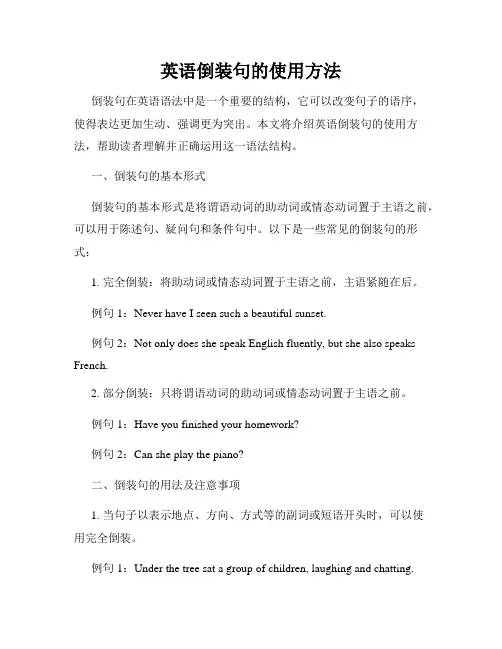
英语倒装句的使用方法倒装句在英语语法中是一个重要的结构,它可以改变句子的语序,使得表达更加生动、强调更为突出。
本文将介绍英语倒装句的使用方法,帮助读者理解并正确运用这一语法结构。
一、倒装句的基本形式倒装句的基本形式是将谓语动词的助动词或情态动词置于主语之前,可以用于陈述句、疑问句和条件句中。
以下是一些常见的倒装句的形式:1. 完全倒装:将助动词或情态动词置于主语之前,主语紧随在后。
例句1:Never have I seen such a beautiful sunset.例句2:Not only does she speak English fluently, but she also speaks French.2. 部分倒装:只将谓语动词的助动词或情态动词置于主语之前。
例句1:Have you finished your homework?例句2:Can she play the piano?二、倒装句的用法及注意事项1. 当句子以表示地点、方向、方式等的副词或短语开头时,可以使用完全倒装。
例句1:Under the tree sat a group of children, laughing and chatting.例句2:On the top of the hill stands a lonely house.2. 在表示否定意义的副词或词组在句首时,可以使用完全倒装。
例句1:Not only did he fail the exam, but he also lost his scholarship.例句2:Never have I been so disappointed.3. 在条件句中,为了强调条件而将“if”或“unless”置于句首时,可以使用完全倒装。
例句1:Should you need any assistance, please do not hesitate to contact us.例句2:Were it not for her guidance, I would not have succeeded.4. 在一些固定的短语或句型中,也常常使用倒装句。
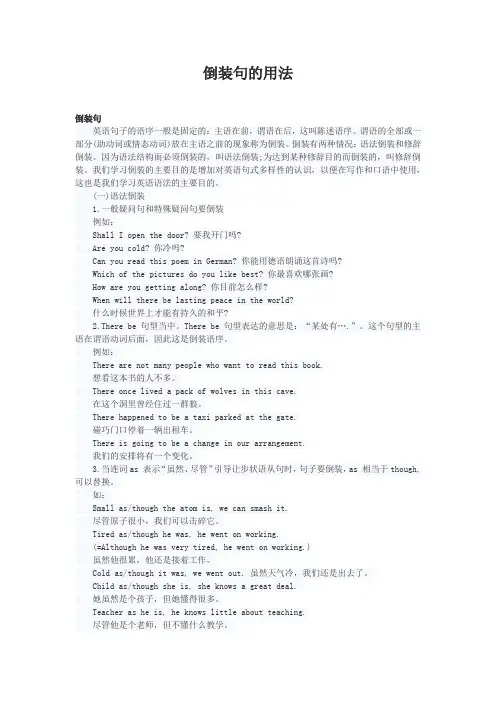
倒装句的用法倒装句英语句子的语序一般是固定的:主语在前,谓语在后,这叫陈述语序。
谓语的全部或一部分(助动词或情态动词)放在主语之前的现象称为倒装。
倒装有两种情况:语法倒装和修辞倒装。
因为语法结构而必须倒装的,叫语法倒装;为达到某种修辞目的而倒装的,叫修辞倒装。
我们学习倒装的主要目的是增加对英语句式多样性的认识,以便在写作和口语中使用,这也是我们学习英语语法的主要目的。
(一)语法倒装1.一般疑问句和特殊疑问句要倒装例如:Shall I open the door? 要我开门吗?Are you cold? 你冷吗?Can you read this poem in German? 你能用德语朗诵这首诗吗?Which of the pictures do you like best? 你最喜欢哪张画?How are you getting along? 你目前怎么样?When will there be lasting peace in the world?什么时候世界上才能有持久的和平?2.There be 句型当中。
There be 句型表达的意思是:“某处有….”。
这个句型的主语在谓语动词后面,因此这是倒装语序。
例如:There are not many people who want to read this book.想看这本书的人不多。
There once lived a pack of wolves in this cave.在这个洞里曾经住过一群狼。
There happened to be a taxi parked at the gate.碰巧门口停着一辆出租车。
There is going to be a change in our arrangement.我们的安排将有一个变化。
3.当连词as 表示“虽然、尽管”引导让步状语从句时,句子要倒装,as 相当于though,可以替换。
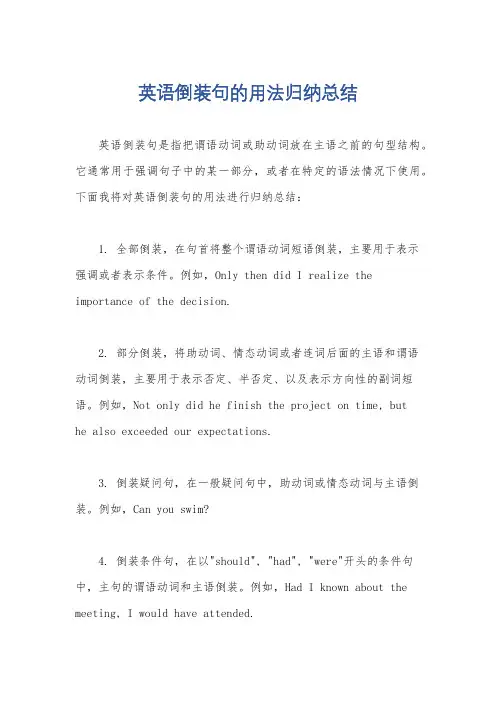
英语倒装句的用法归纳总结
英语倒装句是指把谓语动词或助动词放在主语之前的句型结构。
它通常用于强调句子中的某一部分,或者在特定的语法情况下使用。
下面我将对英语倒装句的用法进行归纳总结:
1. 全部倒装,在句首将整个谓语动词短语倒装,主要用于表示
强调或者表示条件。
例如,Only then did I realize the importance of the decision.
2. 部分倒装,将助动词、情态动词或者连词后面的主语和谓语
动词倒装,主要用于表示否定、半否定、以及表示方向性的副词短语。
例如,Not only did he finish the project on time, but
he also exceeded our expectations.
3. 倒装疑问句,在一般疑问句中,助动词或情态动词与主语倒装。
例如,Can you swim?
4. 倒装条件句,在以"should", "had", "were"开头的条件句中,主句的谓语动词和主语倒装。
例如,Had I known about the meeting, I would have attended.
5. 倒装句型用于表示方向性的副词短语,如,Here comes the bus.
总的来说,英语倒装句的使用有一定的规律,主要用于强调、
条件句、疑问句和特定的副词短语。
在写作和口语表达中,合适地
运用倒装句可以使语言更加生动有力。
希望以上总结对你有所帮助。
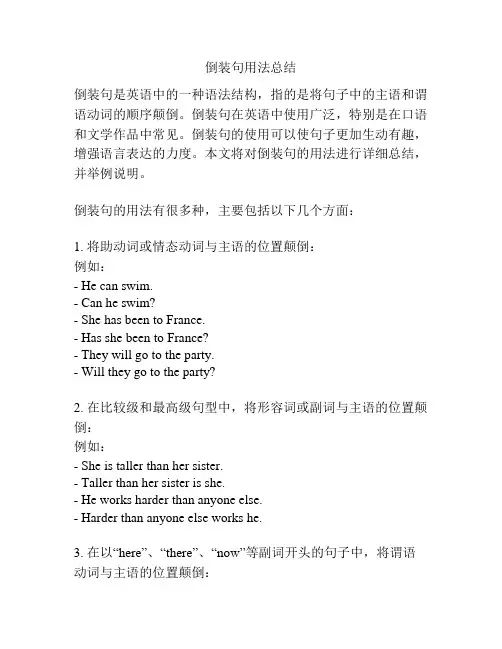
倒装句用法总结倒装句是英语中的一种语法结构,指的是将句子中的主语和谓语动词的顺序颠倒。
倒装句在英语中使用广泛,特别是在口语和文学作品中常见。
倒装句的使用可以使句子更加生动有趣,增强语言表达的力度。
本文将对倒装句的用法进行详细总结,并举例说明。
倒装句的用法有很多种,主要包括以下几个方面:1. 将助动词或情态动词与主语的位置颠倒:例如:- He can swim.- Can he swim?- She has been to France.- Has she been to France?- They will go to the party.- Will they go to the party?2. 在比较级和最高级句型中,将形容词或副词与主语的位置颠倒:例如:- She is taller than her sister.- Taller than her sister is she.- He works harder than anyone else.- Harder than anyone else works he.3. 在以“here”、“there”、“now”等副词开头的句子中,将谓语动词与主语的位置颠倒:例如:- Here comes the bus.- There goes the alarm.- Now is the time.4. 在“only”引导的状语从句中,将谓语动词与主语的位置颠倒:例如:- Only when it snows do we go skiing.- Only after he left did she realize her mistake.5. 在以否定词开头的句子中,将谓语动词与主语的位置颠倒:例如:- Never have I seen such a beautiful sunset.- Seldom does he go to parties.6. 在以“so”引导的倒装句中,将助动词或情态动词与主语的位置颠倒,并用“so”开头:例如:- He is tired, and so am I.- They can swim, and so can we.7. 在祈使句中,将动词原形与主语的位置颠倒,并将“you”省略:例如:- Study hard!- Be quiet!倒装句的使用可以改变句子的语序,使语句结构更加丰富,表达更加灵活。
倒装句的用法与注意事项倒装句是英语语法中一种常用的语法结构,它在句子中把谓语动词或者其他特定成分放在主语之前,以达到强调、插入语效果或者改变语序的目的。
倒装句的使用能够提升语言的表达力和变化句子的节奏。
在本文中,我们将深入探讨倒装句的用法与注意事项。
一、倒装句的基本用法在英语中,倒装句根据具体的语法结构和用途可以分为以下几种:1.全部倒装句全部倒装句是指将谓语动词完全颠倒放在主语之前,通常用于表示地点、时间、条件、方式或情态动词等。
例如:a) In the garden sat two children, playing happily.(花园里坐着两个孩子,快乐地玩耍。
)b) Down the road came a group of cyclists.(沿着马路走来一群骑车的人。
)2.部分倒装句部分倒装句是指将助动词、情态动词或be动词与主语颠倒顺序,用于强调或借以表达一定的情感色彩。
例如:a) Never have I seen such a beautiful sunset.(我从未见过如此美丽的日落。
)b) Not only does she play the piano, but she also sings well.(她不仅会弹钢琴,还会唱歌。
)3.祈使句倒装在祈使句中,主语常常被省略,此时谓语动词直接放在句首,以表示命令、要求、建议等意义。
例如:a) Be quiet!(安静!)b) Sit down, please.(请坐。
)二、倒装句的注意事项在使用倒装句时,需要注意以下几点:1.仅适用于肯定句和祈使句倒装句通常只适用于肯定句和祈使句,而疑问句一般不使用倒装结构。
2.助动词、情态动词和be动词的倒装倒装结构通常在助动词、情态动词和be动词后面使用,而不适用于其他动词。
3.标点符号的使用在倒装句中,标点符号的使用要特别注意。
一般情况下,如果倒装结构作为句子的开始部分,则需要在倒装结构之后使用逗号隔开。
英语里倒装句的用法英语倒装句的用法英语倒装句是英语中很重要的一种句型,难度相对也有点大。
你掌握了吗。
接下来小编在这里给大家带来英语倒装句的用法,我们一起来看看吧!英语倒装句的用法英语中常见的倒装:1. 在疑问句中。
Did you had your hair cut yesterday?2. 在there be 结构中。
There are several students in the classroom.3. 直接引语的一部分或全部放在句首时,有时也用倒装。
" Build up your self-confidence."; said the teacher.4. 在表示方向,地点的副词或某些介词词组开头的里,如there, here, out, in, up, down, away, in front of等,以示强调。
On the top of the hill stands an old temple.Away flew the bird.Out rushed the pupils.但主语是人称代词时,主语和谓语的语序不变。
Here it is.Away he went.5. 含有否定意义的副词或连词,如never, not, not only, little, seldom, hardly等,放在句首时。
Not only am l out-going and active, but also enthusiastic and optimistic.Never will he forget the first day to go to school.Hardly had I got out of the house when it began to rain.基本语序6. Only 所修饰的副词,介词短语或状语从句放在句首时。
Only in this way can you have a good command of a foreign language.Only if you put your mind into something can you get the best result of it.7. So , neither, nor引起的句子,表示前面的情况也适用于另一个人或事物时。
倒装句的形式和用法倒装句是英语语法中常见的句子结构,主语与谓语动词的次序颠倒。
它在英语中具有一定的运用频率,常见于问句、条件句、方位表达等情景。
本文将深入探讨倒装句的形式和用法,以帮助读者更好地理解和掌握倒装句结构。
一、完全倒装句的形式完全倒装句是最常见的倒装句形式。
在完全倒装句中,谓语动词位于主语之前。
1. 在问句中“Where do you live?”(你住在哪里?)→ “Where live you?”(你住在哪里?)2. 在以介词短语开头的句子中“In the garden stood a beautiful flower.”(花园里有一朵美丽的花。
)→ “A beautiful flower stood in the garden.”(花园里有一朵美丽的花。
)3. 在以表示地点的状语或副词开头的句子中“Here comes the bus.”(汽车来了。
)→ “The bus comes here.”(汽车来了。
)二、部分倒装句的形式部分倒装句是指只将助动词、系动词或情态动词置于主语之前。
1. 在条件句中“If I were you, I would study harder.”(要是我是你,我会更加努力学习。
)→ “Were I you, I would study harder.”(要是我是你,我会更加努力学习。
)2. 在以“only”开头的句子中“Only by working hard can you achieve success.”(只有努力工作,你才能获得成功。
)→ “Only by working hard can you achieve success.”(只有努力工作,你才能获得成功。
)三、倒装句的用法1. 在强调句中“Jane has never been to Paris.”(简从未去过巴黎。
)→ “Never has Jane been to Paris.”(简从未去过巴黎。
倒装句型结构及用法英语倒装句是指在句子中调换主语和谓语动词的正常语序,或将动词提前至主语之前的结构。
这种结构在英语中有多种用法,以下是一些常见的倒装句型及其用法:完全倒装:结构:倒装句的完全形式是将助动词或情态动词放在主语之前。
例子:Never have I seen such a beautiful sunset.(我从未见过如此美丽的日落。
)否定副词倒装:结构:当否定副词放在句首时,需要对句子进行倒装。
例子:Rarely does he complain about his workload.(他很少抱怨工作负担。
)表示方向、地点的副词倒装:结构:表示方向、地点的副词位于句首时,句子需要进行倒装。
例子:Up the hill ran the children.(孩子们跑上了山。
)only 修饰副词、介词短语时的倒装:结构:当"only" 修饰副词或介词短语时,通常需要将其置于句首并进行倒装。
例子:Only after finishing his homework can he go out.(只有完成作业,他才能出去。
)so 和neither 引导的倒装句:结构:当"so" 或"neither" 用于引导对等结构的倒装句时,主谓语序颠倒。
例子:"I love pizza." - "So do I."("我喜欢披萨。
" - "我也是。
")倒装问句:结构:在一般陈述句的基础上,将助动词或情态动词提前至主语之前,形成疑问句。
例子:You have finished your homework. →Have you finished your homework?这些是一些常见的倒装句型及其用法。
需要注意的是,并非所有情况下都适用倒装结构,而是要根据具体语境和语法规则来判断。
一、部分倒装:在正式文体中,等含有否定意义的副词若位于句首,则其后要用部分倒装:I shall never forgive him. / Never shall I forgive him. 我永远不会宽恕他。
He seldom goes out for dinner. / Seldom does he go out for dinner. 他很少出去吃饭。
He little realizes how important this meetingis. / Little does he realize howimportant this meeting is. 他不甚明白这个会议的重要性。
注意:(1) 对于 not … until 句型,当 not until…位于句首时,其后的主句要用倒装语序:He didn’t leave the room until the rain stopped. / Not until the rain stopped did he leave the room. 雨停了之后他才离开这房间。
(2) 某些起副词作用的介词短语,由于含有否定词,若位于句首,其后要用部分倒装:On no accounts must this switch be touched. 这个开关是绝不能触摸的。
(3) 但是, in no time(立即,马上)位于句首时,其后无需用倒装语序:In no time he worked out the problem. 他马上就算出了那道题。
当一个状语受副词 only 的修饰且置于句首时,其后用部分倒装语序:Only then did he realize that he was wrong. 到那时他才意识到他错了。
Only in this way are you able to do it well. 你只有用这种方法才能把它做好。
”位于句首时的倒装副词 so 后接形容词或副词位于句首时,其后用部分倒装:So cold was the weather that we had to stay at home. 天气太冷,我们只好呆在家里。
倒装句的用法及注意事项倒装句是英语语法中的一种句子结构,通过将主语和动词的位置颠倒,以强调某一成分或改变句子的语气。
倒装句是英语中的一个重要语法现象,掌握倒装句的用法和注意事项对于提高英语表达的准确性和流利性至关重要。
本文将介绍倒装句的常见用法,并提供一些注意事项供大家参考。
一、完全倒装句完全倒装句是指将助动词、情态动词、系动词或某些动词位于句首,主语位于谓语动词之后的一种句子结构。
常见的情景有:1. 当以表示地点、频率、方向、方式、原因等的副词或短语作为句首状语时,需要使用完全倒装句。
例如:Out of the blue came a loud noise.(突然传来一阵巨响。
)Not until last night did I realize my mistake.(直到昨晚我才意识到我的错误。
)2. 当表示否定的副词或短语放在句首时,需要使用完全倒装句。
例如:Never have I seen such a beautiful sunset.(我从未见过如此美丽的日落。
)Under no circumstances should you give out your personal information.(在任何情况下都不应该泄露个人信息。
)3. 当以倒装词组开头时,需要使用完全倒装句。
例如:Not only does he play the piano, but he also sings.(他不仅会弹钢琴,还会唱歌。
)In no way can we ignore the importance of education.(我们无论如何都不能忽视教育的重要性。
)二、部分倒装句部分倒装句是指将助动词或情态动词置于主语之前,而将主语和谓语动词之间的顺序保持不变的句子结构。
常见的情景有:1. 当以否定词开头时,需要使用部分倒装句。
例如:Never have I been so disappointed.(我从未如此失望过。
英语倒装倒装是一种语法手段,用于表示一定的句子结构或强调某一句子成分。
倒装句有两种:完全倒装和部分倒装。
完全倒装1) 完全倒装即把整个谓语放到主语之前(是整个谓语动词,而非助动词)。
例如:The teacher came in and the class began.(没有倒装)In came the teacher and the class began. (老师走了进来,然后开始上课。
)2) there引出的完全倒装句:除了最常见的there be句型以外,there还可以接appear, exist, lie, remain, seem to be, stand等,一般都译成"有"的含义,构成完全倒装句。
例如:There appeared to be a man in black in the distance.(远处有个穿黑色衣服的人。
)3) 由地点和时间副词引出的完全倒装句:以地点副词here, there和时间副词now, then 开头,后面的动词是be, come, exist, fall, follow, go, lie, remain, seem, stand等,而主语又是名词时,构成完全倒装句。
Up climbed the boy when his mother came.4)表示运动方向的副词或地点状语置于句首,谓语表示运动的动词且主语是名词时使用完全倒装5)在强调状语时1)当句首状语为方位词或拟声词,谓语动词为go, come等表示位置转移的动词时句子须倒装。
例如:1 Up went the plane.2 In came the chairman and the meeting began.注:如果主语是代词则不发生倒装。
例如:1 Out they rushed!2 Lower and lower he bent.(2) 当句首状语为表示地点的介词词组时,句子须倒装。
例如:1 Round the corner walked a large policeman.2Under the table was lying a half-conscious young man.3 当句首状语由“only +副词”,“only +介词词组”,“only +状语从句”构成时,句子须倒装。
例如:1 Only yesterday did he find out that his watch was missing. (不属于完全倒装)2 Only because there were some cancelled bookings did he get some tickets in the end.(6)当句首状语为here, there, now, then等时,句子须倒装,主语是代词时,句子不用倒装。
例如:1)Here is a ticket for you.2)Now comes your turn.3)Here he comes.(7)以关联词so (…that)开头的句子中,句子须倒装。
例如:1)So small was the mark that I could hardly see it.2)So quickly did the workmen finish their work that they were given a bonus.3)So much does he worry about his financial position that he can’t sleep at night.注:在该结构中,“so +形容词”是表语的前置;“so +副词”是状语的前置。
.在直接引语之后在叙事性书面语中,直接引语后常跟asked Mary, answered John, said the old lady, grunted Peter之类的词语。
在这些词语中,动词常的主语之前,主语是代词时,不用倒装。
例如:1)“What do you mean?” asked Henry.2)“What do you mean?” he asked.. often, many a time等表示频度的状语置于句首时例如:Often did they think of going there, but they never had a chance.12.在as, though引导的让步状语从句中在as, though引导的让步状语从句中,一般将形容词、副词或名词等置于句首。
例如:1)Small as the atom is, we can smash it.2)Big as the workpiece is, it is turned out withOut rushed a missile from under the bomber. 轰炸机肚底下窜出一枚导弹。
Out he rushed.注意:1) 在here, there引出的倒装句中,当主语是普通名词时用完全倒装句,但当主语是代词时,就要用部分倒装句。
例:Here comes the postman!(邮递员终于来了!注意实意谓语动词位于主语之前。
)Here we are.(我们到了。
注意系动词位于主语代词之后。
)2) 当主语是代词,谓语是系动词,表语是说明性的词、词组和定语从句时,可以使用完全倒装句,起强调作用。
例:Lucky is he who has been enrolled into a famous university.(他真幸运,被一所名牌大学录取了。
)Typical for China is the crosstalk show where a pair of comedians entertains the audience with word play.(中国典型的是相声表演,两个喜剧演员通过文字游戏逗乐观众)部分倒装解析1) 部分倒装即只把谓语的一部分(如助动词、情态动词等)放到主语前,或把句子的强调成分提前。
Nor did he let the disease stop him from living the kind of life he has always dreamt about(疾病没有使他放弃过上梦想中的生活)2) 以否定词开头的句子要求部分倒装。
注意下列句子中助动词或情态动词提前、甚至补充助动词的用法:例:Not until yesterday did little John change his mind.(小约翰直到昨天才改变了主意。
)In no country other than Britain, it had been said, can one experience four seasons in the course of a single day.(据说除了英国世界上没有哪个国家能让人在一天中感受到四季变化)3) 以否定副词开头并加状语放在句首的句子要求部分倒装。
这些否定副词有barely, hardly, little, seldom, scarcely…… when, never, no sooner…… than, rarely, no more, not nearly, not only等以及only。
Only in the country can you learn the “true English”.4)一些如scarcely……when, no sooner ……than, hardly……when引导的主从复合句主句要求使用过去完成式。
注意:在部分倒装句中,只有助动词、情态动词或连系动词to be可以置于主语之前,其它部分都要置于主语之后。
5)此外,一些介词+no+名词的结构中需要用部分倒装,这些结构包括at no time; by no means; by no manner of means; for no reason; in no case; in/under no circumstances; in no sense; in no way; on no account; on no consideration; at no point例如Under no circumstances should you lend Paul any money. 注意:a) 如果含有从句时,只要求主句倒装:例:Only after he had spoken out the word did he realize he had made a big mistake.(只有当他已经说出那个字后才意识到自己犯了个大错误。
)b) 如果上述否定副词出现在强调句型中的前半部分,不用倒装:例:It was not until he went abroad that he knew the truth of the fact.(直到他出国以后才了解到事实真相。
)c) 如果hardly, scarcely后面接的是any, ever, at all时,意义类似almost no/ not/ never(几乎不、从不),则无须倒装。
例:Hardly any people invited went there.(几乎没有什么受到邀请的人去那里了。
)6) 由no matter how, however和how引导的状语从句要求部分倒装,因为形容词或副词通常紧跟在这三个引导词后面,然后才是主语和谓语,形成形式上的部分倒装句:例:I know nothing about this river, neither how long, how wide nor how deep it is.(我一点也不了解这条河,不知道它有多长,多宽或多深。
)7) 由as引导的部分倒装句:a) 当as作为比较意义时,即用于as + adj./ adv. + as结构中时,如果把第一个as 省略掉,就形成部分倒装句。
例:Cautious as the rest of her family (was) , she didn't seem willing to give an immediate reply to my question.(正如她家里人一样谨慎小心,她似乎不愿意立即回答我的问题。
)She charged the stairs, quick as a rabbit (ran).(她跑上楼去,跑得象兔子那么快!)b) 当as引导让步状语时,和although, though一样,当用作“尽管”之义时,可以用于部分倒装句。